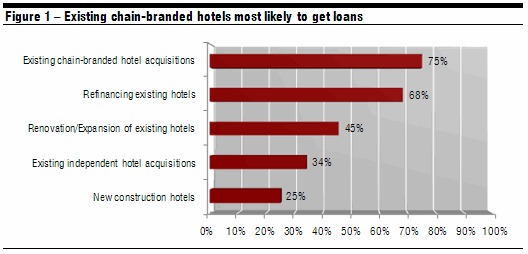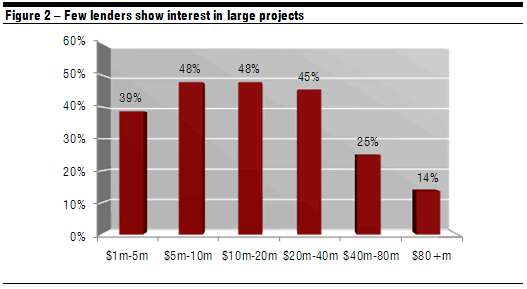Hotel Lending Remains Slow - Bigger Loans Stall but Smaller Loans Pick-up Slightly - By Jimmy J Bae and Hans Detlefsen
HVS conducted a confidential survey of approximately 800 lenders from around the world to gather their input about the current conditions of lending in the hospitality sector.
During January and February, HVS conducted a confidential survey of approximately 8001 lenders from around the world to gather their input about the current conditions of lending in the hospitality sector. A total of 44 responded for a response rate of roughly 5.5%. This article provides an overview of some key findings from our lender survey.
Summary of Findings
HVS asked lenders to identify which sorts of hotel projects they would consider for loans currently.

As indicated in the preceding chart, most of the lenders are considering loans for either existing chain-branded hotel acquisitions or refinancing existing hotels. The preceding chart also indicates that fewer than half of the respondents are currently considering lending for renovations or expansions of existing hotels. Loans are scarcer yet for investors seeking to acquire independent hotels; only 34% of the lenders are currently considering making loans for existing independent hotel acquisitions. Only 25% of the survey participants are considering loans for new hotel construction currently.
HVS asked lenders to identify: "the maximum loan size you would currently consider for lodging property loans?"

As illustrated in the preceding chart, nearly half of the survey participants would consider loan sizes up to $20 million. Approximately 45% would consider loans up to $40 million at this time, which represents an increase since our last survey in the third quarter of 2009. According to feedback provided by lenders, the following table summarizes the range and median of the loan-to-value ratios considered appropriate for each of the loan size ranges indicated in the preceding chart.

For all but the smallest loans, the loan-to-value ratios currently considered acceptable by lenders is generally in the range of 50% to 65%.
Next, several questions in the survey asked lenders to identify current lending parameters such as the most appropriate debt-coverage ratio, amortization period, loan term, and interest rates they are currently considering for hotel loans. The findings are summarized as follows and represent the most frequent responses of lenders who participated in the survey.
- DCR = 1.3 to 1.5 (ranged between 1.2 and 2.0)
- 46% calculate DCR based on historical
- 39% calculate DCR based on stabilized-year
- 15% calculate DCR based on first-year projections
- Amortization period = 20 to 25 years
- Loan term = 3 to 5 years (ranged between 1 and 10)
- Interest rate2 = 7.5% to 8.5%
In the current environment, the vast majority of lenders are only willing to consider recourse loans and significant collateral is required. Therefore, HVS asked survey respondents to identify "what collateral is required for a typical hotel loan," "what are the most important characteristics that lenders seek in a borrower," and "what are the most important characteristics that lenders seek in a hotel project." The key findings are summarized in the following points.
Required Collateral for a Hotel Loan
- Land, improvements, FF&E
- First mortgage, additional shareholder or management operator guarantees
- Personal guarantees, letters of credit, ground lease
- High cash equity, lien on shares and all assets
Important Characteristics for a Borrower
- Ownership experience with proven track record
- Depth and structure of management team
- Strategy and risk policies
- Capital, financial stability, access to equity, net worth
- Integrity, credit history, brand support, reputation
Important Characteristics for a Hotel Project
- Reliable projections of future operating performance
- Market, location, demographics
- Brand, experience, sponsor, asset’s size, type, age, and operator
- Loan structure, appropriate leverage and DCR
- CapEx and maintenance schedules and history
- Competitive existing supply, new supply
- Solid history of cash flow and a strong balance sheet
Conclusion
As many believe the economy has begun to emerge from recession in early 2010, significant uncertainty remains about the economy and many lenders are being affected by continued declines in hotel values backing their existing loans. As a result, the availability of loans in the hospitality sector continued to be limited. Although economic conditions have stabilized and show early signs of recovery, investors in the hospitality industry are still cautious with capital. With loan-to-value ratios remaining around 50% to 65% and interest rates increasing to near 8.5%, we expect to see a relative increase in the number of all-cash transactions in the hospitality sector compared to recent years. Most banks and non-bank lenders have remained selective in their loan underwriting and many are preserving capital for other uses. The fact that lenders continue to require high levels of equity and collateral from borrowers is likely to lead to a significant decline in supply growth in the near-term. Moreover, many existing hotels will need to be refinanced in the next three to five years. If loan-to-value ratios remain at current levels, this implies that a large number of owners will need to contribute additional equity to their hotels or convince lenders to extend the terms on existing loans.
1 The survey was initially sent to 1,180 lenders worldwide via email. After three rounds of surveys, we removed approximately 380 email addresses that we determined were inactive.
2 Rate based on floating rate; add 100-200bps for fixed rate.
http://www.hvs.com/
